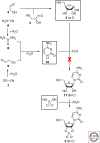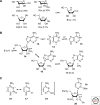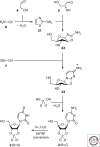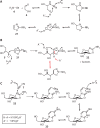Ribonucleotides
- PMID: 20452951
- PMCID: PMC2845210
- DOI: 10.1101/cshperspect.a005439
Ribonucleotides
Abstract
It has normally been assumed that ribonucleotides arose on the early Earth through a process in which ribose, the nucleobases, and phosphate became conjoined. However, under plausible prebiotic conditions, condensation of nucleobases with ribose to give beta-ribonucleosides is fraught with difficulties. The reaction with purine nucleobases is low-yielding and the reaction with the canonical pyrimidine nucleobases does not work at all. The reasons for these difficulties are considered and an alternative high-yielding synthesis of pyrimidine nucleotides is discussed. Fitting the new synthesis to a plausible geochemical scenario is a remaining challenge but the prospects appear good. Discovery of an improved method of purine synthesis, and an efficient means of stringing activated nucleotides together, will provide underpinning support to those theories that posit a central role for RNA in the origins of life.
Figures






Similar articles
-
Synthesis of activated pyrimidine ribonucleotides in prebiotically plausible conditions.Nature. 2009 May 14;459(7244):239-42. doi: 10.1038/nature08013. Nature. 2009. PMID: 19444213
-
A Prebiotic Synthesis of Canonical Pyrimidine and Purine Ribonucleotides.Astrobiology. 2019 May;19(5):669-674. doi: 10.1089/ast.2018.1935. Epub 2019 Jan 30. Astrobiology. 2019. PMID: 30698463 Free PMC article.
-
Divergent prebiotic synthesis of pyrimidine and 8-oxo-purine ribonucleotides.Nat Commun. 2017 May 19;8:15270. doi: 10.1038/ncomms15270. Nat Commun. 2017. PMID: 28524845 Free PMC article.
-
Purine Chemistry in the Early RNA World at the Origins of Life: From RNA and Nucleobases Lesions to Current Key Metabolic Routes.Chembiochem. 2025 Jun 3;26(11):e202500035. doi: 10.1002/cbic.202500035. Epub 2025 Apr 16. Chembiochem. 2025. PMID: 40237374 Free PMC article. Review.
-
Chemistry of Abiotic Nucleotide Synthesis.Chem Rev. 2020 Jun 10;120(11):4766-4805. doi: 10.1021/acs.chemrev.9b00546. Epub 2020 Jan 9. Chem Rev. 2020. PMID: 31916751 Review.
Cited by
-
A Step toward Molecular Evolution of RNA: Ribose Binds to Prebiotic Fatty Acid Membranes, and Nucleosides Bind Better than Individual Bases Do.Chembiochem. 2020 Oct 1;21(19):2764-2767. doi: 10.1002/cbic.202000260. Epub 2020 Jun 5. Chembiochem. 2020. PMID: 32358921 Free PMC article.
-
Exploring the Emergence of RNA Nucleosides and Nucleotides on the Early Earth.Life (Basel). 2018 Nov 6;8(4):57. doi: 10.3390/life8040057. Life (Basel). 2018. PMID: 30404133 Free PMC article. Review.
-
Refining the genetic alphabet: a late-period selection pressure?Astrobiology. 2012 Sep;12(9):884-91. doi: 10.1089/ast.2011.0789. Astrobiology. 2012. PMID: 22984873 Free PMC article.
-
Bioenergetics and life's origins.Cold Spring Harb Perspect Biol. 2010 Feb;2(2):a004929. doi: 10.1101/cshperspect.a004929. Cold Spring Harb Perspect Biol. 2010. PMID: 20182625 Free PMC article. Review.
-
Primitive genetic polymers.Cold Spring Harb Perspect Biol. 2010 Dec;2(12):a002196. doi: 10.1101/cshperspect.a002196. Epub 2010 May 12. Cold Spring Harb Perspect Biol. 2010. PMID: 20462999 Free PMC article. Review.
References
-
- Anastasi C, Buchet FF, Crowe MA, Helliwell M, Raftery J, Sutherland JD 2008. The search for a potentially prebiotic synthesis of nucleotides via arabinose-3-phosphate and its cyanamide derivative. Chem Eur J 14:2375–2388 - PubMed
-
- Anastasi C, Buchet FF, Crowe MA, Parkes AL, Powner MW, Smith JM, Sutherland JD 2007. RNA: Prebiotic product or biotic invention? Chem Biodiversity 4:721–739 - PubMed
-
- Anastasi C, Crowe MA, Powner MW, Sutherland JD 2006. Direct assembly of nucleoside precursors from two- and three-carbon units. Angew Chem Int Ed 45:6176–6179 - PubMed
-
- Borsenberger V, Crowe MA, Lehbauer J, Raftery J, Helliwell M, Bhutia K, Cox T, Sutherland JD 2004. Exploratory studies to investigate a linked prebiotic origin of RNA and coded peptides. Chem Biodiversity 1:203–246 - PubMed
-
- Bryant DE, Kee TP 2006. Direct evidence for the availability of reactive, water soluble phosphorus on the early Earth. H-phosphinic acid from the Nantan meteorite. Chem Commun 14:2344–2346 - PubMed
Publication types
MeSH terms
Substances
Grants and funding
LinkOut - more resources
Full Text Sources
